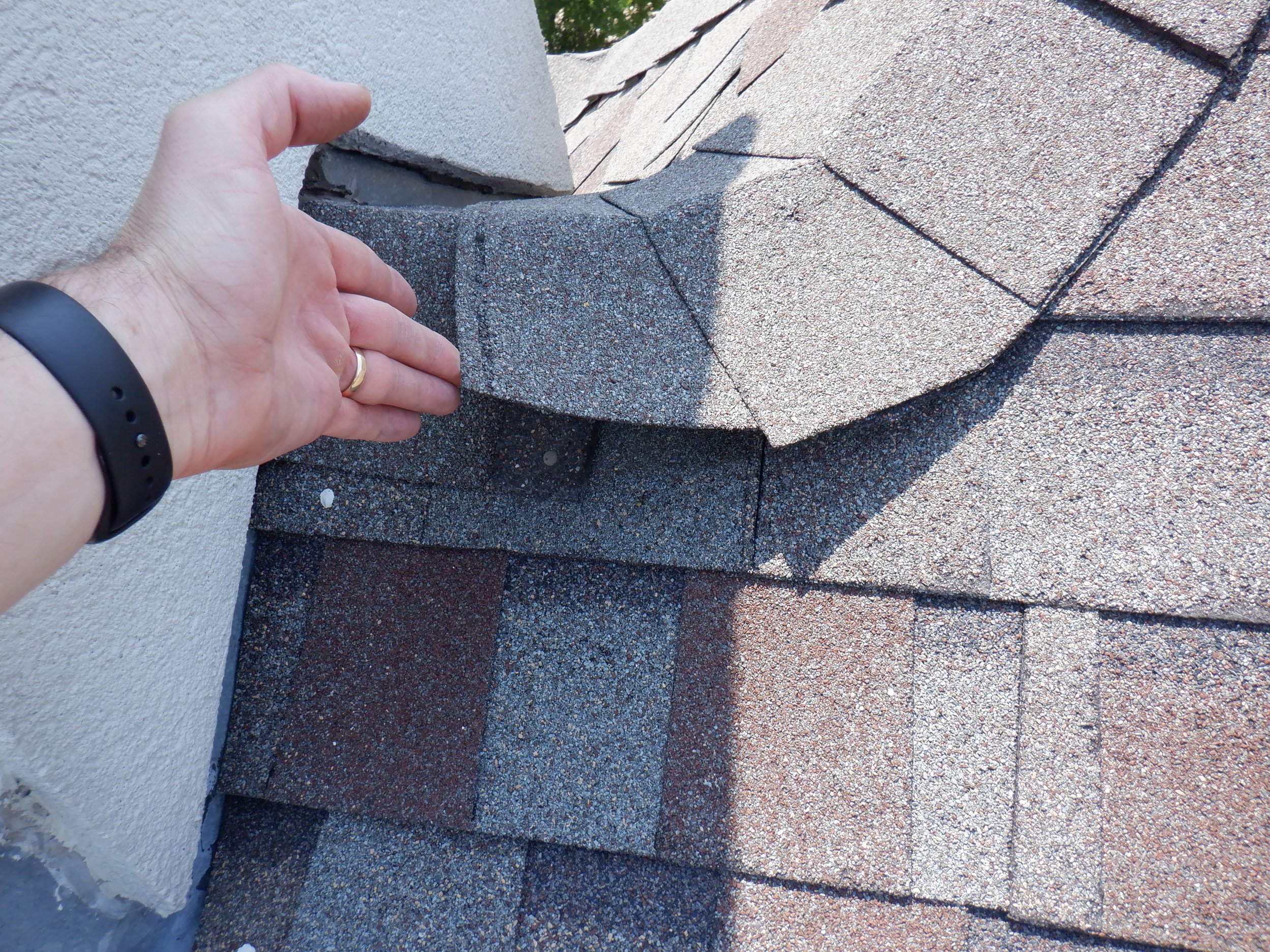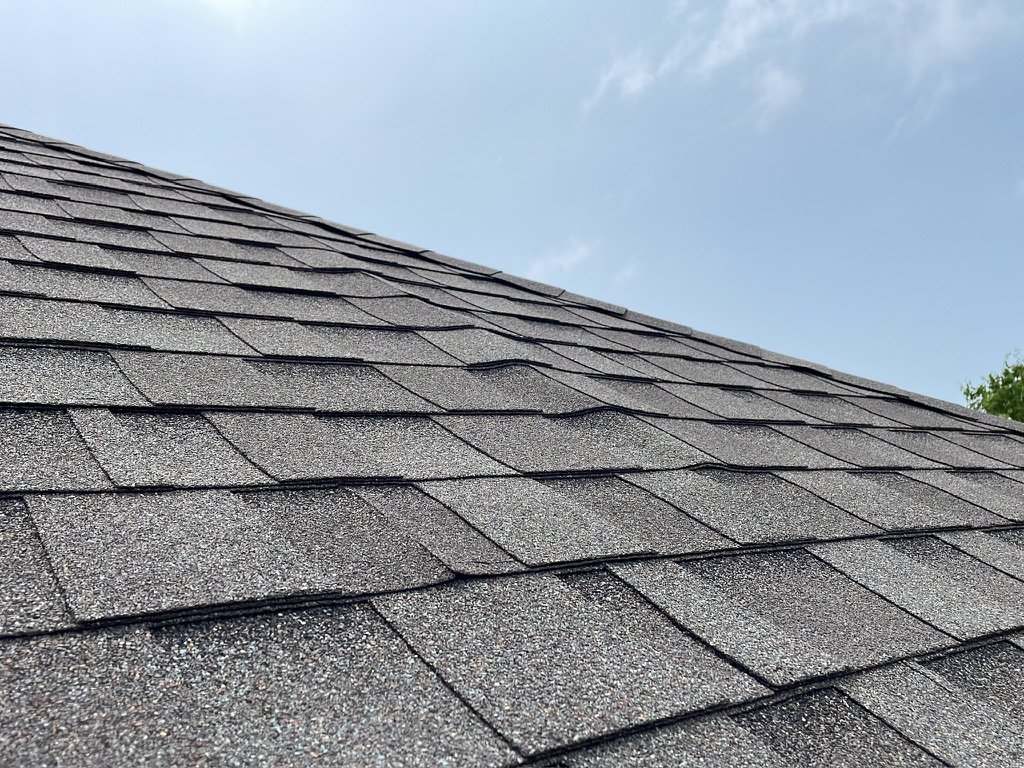Should I Get My New Asphalt Shingle Roof Inspected?
Asphalt shingle roofs dominate the market as the most popular type of roof covering. And it’s no wonder: asphalt roofs are more affordable than other roof systems, last 20 to 30 years or more, and come in a variety of styles and colors. Asphalt shingles are also easy and quick to install, and so are the favorite with new home builders all over North America, and the the Dallas-Ft. Worth metroplex.
So if you are buying a new DFW home with a new roof, should you get a home inspection? Yes, you definitely should. There are many reasons, but here, we will focus on why your new roof needs to be inspected. Homes in DFW have to deal with more heat, more rain, and more wind than than those in many other parts of the country. Roof shingle quality can vary greatly between manufacturers and even among products from the same company. However, the #1 reason roofs leak or fail before their expected service life is improper installation. Worse, your roof warranty may be voided due to the contractor’s failure to follow the manufacturer’s installation instructions.
During a home inspection, we look for indications that proper roofing practices were used in the selection and installation of your roof system. Although most issues we find during a roof inspection are small, they can cause leaks after only a few rainy seasons. Occasionally, we find bigger issues, where the entire roof system is installed improperly and correction is expensive.
All roofing issues can be fixed. Our goal is to equip you with information about your roof to prevent headaches and unplanned costs after you move in. So let’s get to the good stuff. What could exactly go wrong with a brand new roof?
Improperly Installed Drip Edge
Drip Edge Flashing Installation Detail / Image courtesy of Gibralter Building Products
The drip edge is a metal strip that is installed at the edges of the roof to protect it from moisture damage. It is not required by all roof covering manufacturers, but gets installed on the majority of new homes. Some building codes do require it, but also have exceptions. Since most roof leaks occur at penetrations such as plumbing vents, or at the edges, installing drip edges makes sense. However, if the drip edge is installed on top of the underlayment or the underlayment is cut too short, and does not overlap the drip edge, it does not offer the intended protection.
Improper Drip Edge Installation #1: One year warranty inspection in Royce City, TX
The metal drip edge has been nailed on top of the underlayment (white material) at the eaves. It should be installed beneath the underlayment so that moisture that gets beneath the shingles is shed off the roof.
Improper Drip Edge Installation #2: New home inspection in Caddo Mills, TX
Drip edge along the rakes (the sloped edges of the roof) should be installed over the underlayment. Here the underlayment was cut sloppily, exposing the wood decking. The corner is also not adequately fastened, making it susceptible to wind damage.
2. Improperly Installed Starter Strip
Detail from Installation detail for Heritage® Architectural Asphalt Shingles, Courtesy of Tamko Building Products LLC, Dallas TX
A properly installed starter course is designed to help prevent wind damage. Shingles generally come with a factory applied adhesive strip that glues overlapping shingles together. This protects the edges of the shingles from wind uplift. For the very first course of shingles, installed along the roof eaves, there is no adhesive strip to attach to, making this first course of shingles vulnerable to wind. To resolve this problem, a starter course is installed. Manufactures sell starter course shingles, rolls, or allow normal shingles with the tabs are cut off to be used for a starter strip. This will allow the adhesive on the top of the shingle to adhere to the tabs on the first course of shingles. An improperly installed starter course can makes shingles along the eaves susceptible to wind damage by allowing wind to get under the shingles. As a result, shingles are bent up and eventually break off.
No Starter Strip: 3 year old home in Caddo Mills, TX
Without the adhesive sealant securing the edge of the first course of shingles, there is little to prevent a strong windstorm from lifting and tearing off the shingles.
If you are considering a new home purchase in the Dallas/Ft. Worth metro, contact Kingsway Inspections for a detailed evaluation of your home — and the roof.
3. Missing Diverter Flashing
Detail courtesy of Western States Roofing Contractors Association (WSRCA).
Diverter flashing (also called kickout flashing) is installed to protect walls from moisture where side walls meet roof surfaces. It works by diverting roof runoff away from the wall, and into the gutter, if gutters are installed. Without diverter flashing, roof runoff may run down the wall below, and may also get behind the siding. The result is unsightly stains, and sometimes, structural decay inside the walls.
Missing Diverter Flashing: 11 month old roof in Royce City, TX
The missing diverter flashing at this newer home will likely not be noticed for a while. However, as soon as the gray sealant pulls away from the brick surface, runoff will drain down the brick veneer. If there are open control joints, or an opening for a light fixture, water may get inside the wall.
Image courtesy of Dept. of Energy Efficiency & Renewal Energy
Structural Damage Caused by Missing Flashing
The damage to the wall framing of this home will likely cost thousands of dollars. Whenever it rains, some of the runoff got inside framing through the space between the gutter end cap and the wall. There is often a hole left in this area if the gutters are installed before the siding is finished due to lack of working room. When The diverter flashing that could have prevented it costs less than a dollar.
Properly Installed Diverter Flashing
Diverter flashings are easily installed before siding goes on the walls. It is also not difficult to do after the building is finished. (Image courtesy of Klaus Roofing Systems, Columbus, OH.)
Missing diverter flashings are one of a number of issues we look for during your home inspection. They can easily be installed, if you know about it before you buy. Schedule your inspection today — our service area includes the entire DFW metro.
4. Dead Valleys
This is a dead valley on a roof that is less than one year old. This roof design concentrates all the runoff from three roof slopes into a tiny area, increasing the likelihood of a leak.
Dead valleys occur when two roof slopes meet a way that does not allow proper drainage. Either the bottom of the valley terminates in either a dead end or in a shallow area. Either way, the runoff has nowhere to go, or else drains very slowly. This condition can result in constant debris accumulation and roof leakage. It can be an expensive repair and lead to premature roof failure. In our opinion, dead valleys are the result of poor planning at the design stage or else poorly done framing during construction. Either way, they are something you want to know about if you are buying a new home.
Dead Valley with Low Slope
In this version of a dead valley, the steep roof slope ends in a shallow area that falls only 2 inches per foot. Since asphalt shingle roofs are not waterproof, this is the minimum slope allowed, and only with doubled underlayment. This dead valley slope measured at slightly less than 2:12. This means that the roof does not shed water fast enough to prevent it from backing up under the shingles. Also visible is decay in the siding and soffit due to lack of space between the edges and roof surface.
This is the view from the eaves below the same dead valley. After the 2:12 slope section, the roof slope changes to 4:12 for the last six feet of the roof.
4. Other Deficiencies
There are other issues we see on new homes. Several more are listed below.
Unsealed California Cut Valleys
A common practice with closed valleys (where shingles cover the entire valley) is to cut the shingle edges of the larger or steeper slope to create a straight edge, or else to use a course of shingles installed up the valley at an angle to create the edge. Where this is done, the cut side should be sealed down to the underlying shingles to prevent runoff from getting beneath them during heavy rain.
Another example of a California cut valley. The edge is well-sealed to the underlying courses.
Improperly Secured Ridge Shingles
Ridge shingles are installed along the ridges and hips of the roof, making them more vulnerable to wind. They should be fastened with nails that need to be longer than what is used for the rest of the roof due to extra layers that need to be penetrated, and they should be sealed with roofing cement as well. We tend to find poorly installed ridge shingles at turns and at places where the ridge meets roof hips.
Exposed Fasteners
Asphalt roofs are designed to have fasteners covered by shingles on overlying courses. Any fasteners that cannot be covered should be sealed with roofing cement. At the top of the gable of this new home, it is likely not going to be an issue, but the same exposed fasteners in a valley would probably cause noticeable leakage.
Hail Damage
No list of roof issues in the metroplex would be complete without hail damage. Hail can affect houses of any age, although it is more common on older roofes
Roof Structure Deficiencies
This roof, less than a year old already shows sagging in the roof deck below this gable. Although we could not determine the cause without invasive inspection, this is likely due to missing framing resulting in over-spanned plywood roof deck.
Satellite Dishes
Even when properly installed, the screws used to mount dishes through roof shingles create a vulnerability. It is common to find decayed roof decking below the mounting brackets. If possible, mounting satellite dishes through the shingles should be avoided. There are alternate mounting methods available. If the dish is removed, the holes should be sealed with roofing cement.
Buckled Shingles
Buckled shingles can be the result of weather or installation practices. Both asphalt shingles and the roof deck they are fastened to will expand and contract with changes in moisture content and temperature. On this new roof, the buckling will not likely be a problem for a while. However, it will remain vulnerable to wind damage.
During a home inspection in McKinney, we noticed this buckled area, to the left of the valley. Shingles had gotten torn off by wind in the middle of the buckled section, exposing the underlayment below. The roof was at the end of its service life and needed to be replaced, but this heavily damaged section is probably the result of the buckled shingles, which would have been visible soon after installation.
Conclusion
So if you are buying a new DFW home, should you get a home inspection? The answer is a definite Yes! Most roof leaks, especially those occurring soon after installation, are the result of improper installation. Don’t let roof issues surprise you after you close on your home purchase. Contact us today for a free estimate or schedule your inspection online right now. If we recommend further evaluation or repairs, we encourage you to visit our Trusted Providers page, which includes local roofers we recommend. We get no financial compensation from these companies and refer them as a service to our clients.























